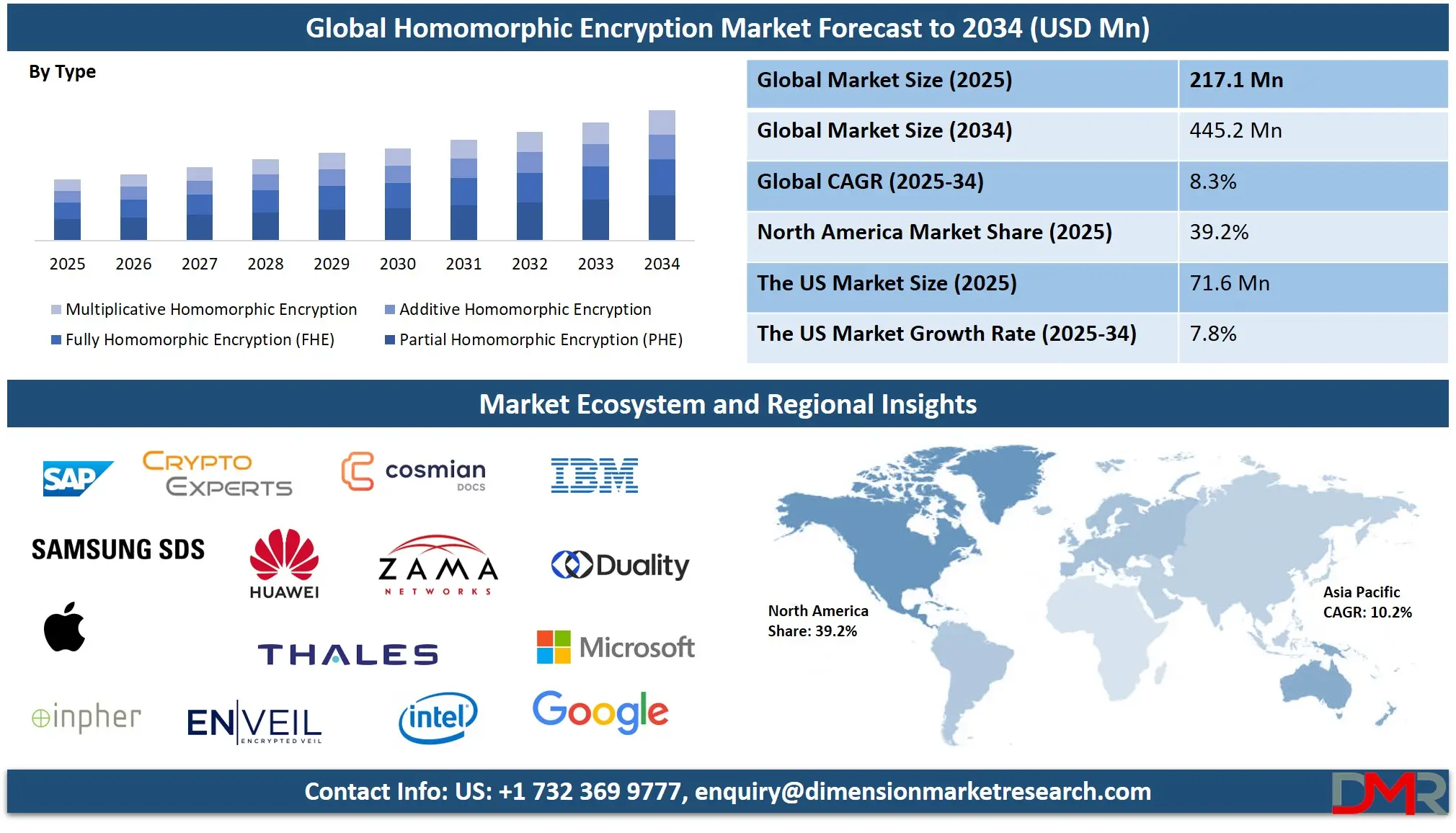
A notable trend in this market is the growing integration of homomorphic encryption with cloud computing and artificial intelligence. Organizations are turning to privacy-enhancing technologies that can enable safe computation in untrusted environments, such as public clouds. Innovations in fully homomorphic encryption (FHE) schemes are making it possible to apply machine learning to encrypted datasets, thus unlocking the value of data while keeping it private.
Significant opportunities exist in the healthcare and fintech sectors, where data sensitivity and compliance requirements are especially high. Homomorphic encryption facilitates secure electronic health records, confidential financial modeling, and anti-fraud analytics without data exposure.
Nevertheless, the technology faces restraints. Homomorphic encryption is computationally intensive, leading to slower processing speeds and higher resource consumption compared to traditional methods. The lack of industry-wide standardization and technical complexity further hinders adoption, especially for small and mid-sized firms.
Despite these barriers, the long-term growth prospects remain strong. Continuous academic and commercial research, combined with regulatory momentum toward privacy, are set to drive broader implementation in the coming decade.
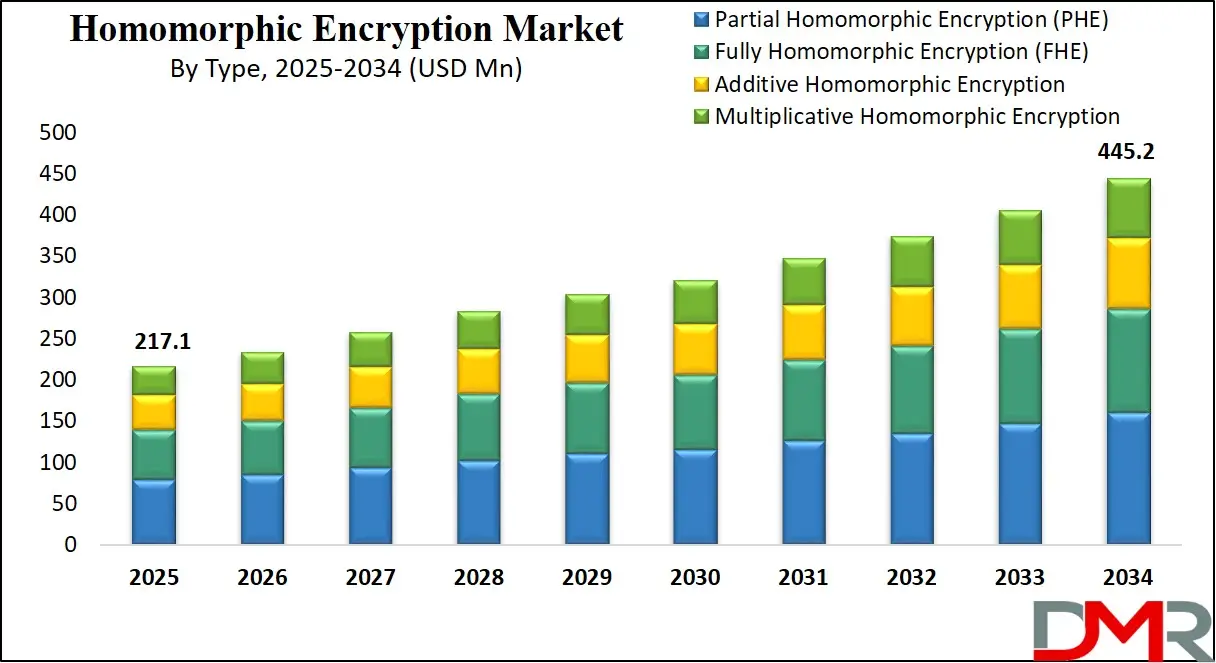
The US Homomorphic Encryption Market
The US Homomorphic Encryption Market is projected to reach
USD 71.6 million in 2025 at a compound annual growth rate of
7.8% over its forecast period.
The U.S. homomorphic encryption market is witnessing significant momentum, underpinned by a strong regulatory framework, an innovation ecosystem, and advanced data infrastructure. Government policies like the Health Insurance Portability and Accountability Act (HIPAA), the Federal Risk and Authorization Management Program (FedRAMP), and the California Consumer Privacy Act (CCPA) have intensified focus on data protection, prompting widespread interest in privacy-preserving technologies such as homomorphic encryption. These regulations incentivize private and public sectors to adopt solutions that maintain compliance without compromising operational data utility.
The United States Census Bureau reports that nearly 93% of American households had internet access in 2023, a strong foundation for digital transformation across sectors. In finance and healthcare, two of the most data-intensive domains, this access, coupled with demographic diversity, generates enormous volumes of sensitive personal information. Homomorphic encryption addresses the challenge of deriving insights from this data without revealing its content, making it a natural fit for the U.S. market.
Research institutions, including federally funded labs and major universities, contribute to advancements in homomorphic encryption. The National Institute of Standards and Technology (NIST) actively supports post-quantum cryptography research, including privacy-enhancing computation techniques. This bolsters both academic and commercial innovation in the field.
Moreover, the U.S. workforce includes a high number of data scientists and cybersecurity professionals, enabling faster technology adoption. While computational efficiency remains a challenge, investments in hardware acceleration and algorithm optimization are steadily reducing latency and cost barriers. As data breaches continue to rise, the U.S. is expected to remain a front-runner in deploying homomorphic encryption at scale.
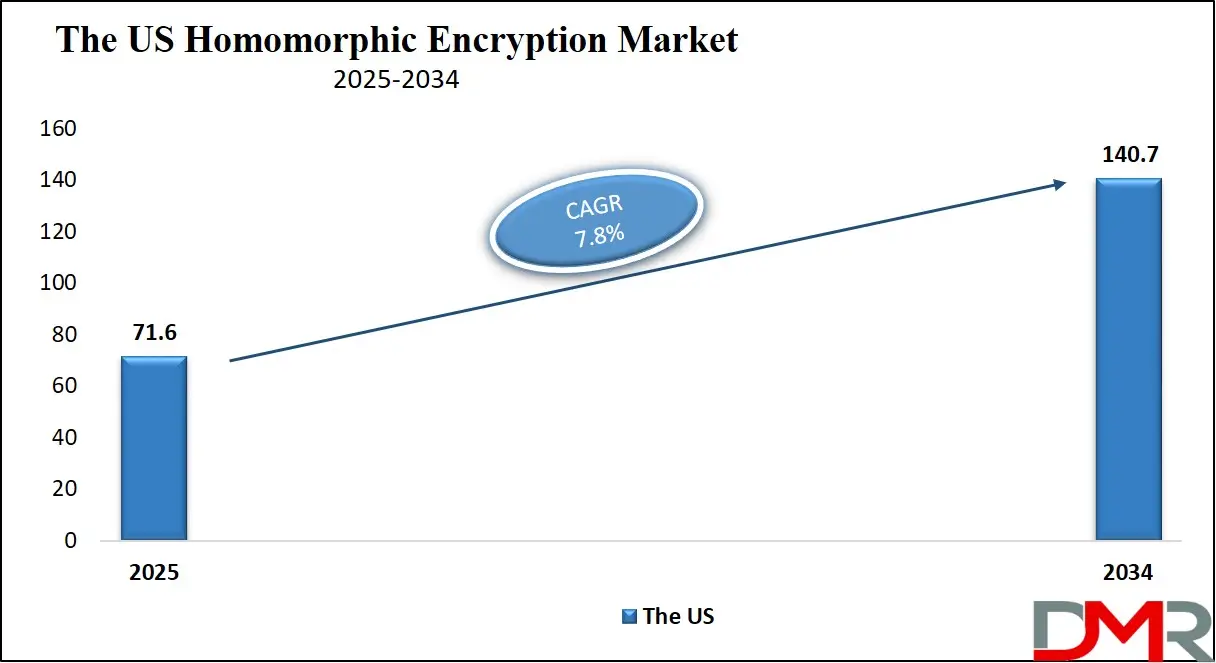
The European Homomorphic Encryption Market
The European Homomorphic Encryption Market is estimated to be valued at
USD 32.57 million in 2025 and is further anticipated to reach
USD 50.52 million by 2034 at a
CAGR of 5.0%.
The European homomorphic encryption market is expanding, supported by a policy-driven commitment to data sovereignty, digital integrity, and consumer privacy. The General Data Protection Regulation (GDPR), implemented by the European Union, has become a global benchmark for data security legislation. This strict regulatory landscape has motivated enterprises across industries to adopt advanced cryptographic methods, with homomorphic encryption gaining special attention for its privacy-preserving capabilities.
National governments across Europe, including those of Germany, France, and the Netherlands, are investing in secure digital infrastructure and post-quantum cryptographic research. Initiatives such as the European Cybersecurity Act and the Digital Europe Programme promote the development and deployment of privacy-enhancing technologies. Homomorphic encryption fits naturally into this ecosystem, offering solutions for cross-border data processing, secure cloud migration, and AI development under the umbrella of privacy by design.
According to Eurostat, the EU-27 population surpassed 447 million in 2024, with a rapidly aging demographic driving digital healthcare demand. Homomorphic encryption offers a path to secure health data sharing and AI-driven diagnostics without breaching patient privacy. In finance, regulatory compliance (e.g., PSD2 and AMLD5) further encourages the adoption of strong data protection protocols.
Challenges persist, including high computational costs and a lack of widespread interoperability standards. However, the European market benefits from strong public-private research collaborations, robust education systems, and a highly informed consumer base. As encryption research matures and processors become more capable, Europe is expected to play a key role in shaping the global privacy-preserving technology landscape.
The Japan Homomorphic Encryption Market
The Japan Homomorphic Encryption Market is projected to be valued at USD 8.68 million in 2025. It is further expected to witness subsequent growth in the upcoming period, holding USD 14.67 million in 2034 at a CAGR of 6.0%.
Japan’s homomorphic encryption market is emerging steadily, fueled by national priorities surrounding digital transformation, public trust in technology, and an aging population. As part of its "Society 5.0" initiative, Japan promotes a data-driven economy where artificial intelligence, big data, and cloud platforms are seamlessly integrated into everyday life. Protecting citizen data within this framework is a critical priority, and homomorphic encryption offers a means of doing so without compromising usability.
With over 125 million residents and a median age of 49, Japan faces escalating demand for secure health data processing. Government programs like the "My Number" identification system and national health insurance databases necessitate privacy-preserving technologies. Homomorphic encryption can facilitate secure sharing of medical histories, diagnostics, and clinical trial data between hospitals and researchers, aligning with Japan’s universal healthcare goals.
The Ministry of Internal Affairs and Communications (MIC) has also emphasized the need for post-quantum cryptography and privacy-enhancing computation. This aligns with efforts by Japanese universities and R&D institutions to develop efficient encryption libraries and integrate them into industrial and financial applications. Furthermore, sectors such as smart manufacturing and robotics are deploying encrypted data flows to safeguard intellectual property and operational data.
Despite its advantages, adoption is hampered by computational overhead and limited public familiarity with homomorphic encryption. However, Japan’s well-established electronics and semiconductor sectors are contributing to algorithm acceleration and hardware support. As trust, regulation, and technical readiness converge, Japan is expected to become a strategic hub for homomorphic encryption development and implementation in the Asia-Pacific region.
Global Homomorphic Encryption Market: Key Takeaways
- • Global Market Size Insights: The Global Homomorphic Encryption Market size is estimated to have a value of USD 217.1 million in 2025 and is expected to reach USD 445.2 million by the end of 2034.
- • The US Market Size Insights: The US Homomorphic Encryption Market is projected to be valued at USD 71.6 million in 2025. It is expected to witness subsequent growth in the upcoming period as it holds USD 140.7 million in 2034 at a CAGR of 7.8%.
- • Regional Insights: North America is expected to have the largest market share in the Global Homomorphic Encryption Market with a share of about 39.2% in 2025.
- • Key Players: Some of the major key players in the Global Homomorphic Encryption Market are Microsoft Corporation, International Business Machines Corporation (IBM), Google LLC, Intel Corporation, Thales Group, Duality Technologies Inc., Zama Inc., Enveil Corporation, Inpher Inc., Cosmian, ShieldIO, CryptoExperts SAS, and many others.
- • The Global Market Growth Rate: The market is growing at a CAGR of 8.3 percent over the forecasted period of 2025.
Global Homomorphic Encryption Market: Use Cases
- Secure Financial Risk Modeling: Banks use homomorphic encryption to develop credit scoring and fraud detection models on encrypted data. This enables accurate risk analysis while ensuring that customer financial records remain private, aligning with financial compliance regulations and reducing the risk of internal data leaks or breaches.
- Privacy-Preserving Genomic Research: Biomedical researchers use homomorphic encryption to process and analyze encrypted genetic data. This preserves individual privacy while allowing institutions to share and compute over large genomic datasets, essential for developing targeted therapies and advancing medical research without compromising patient confidentiality.
- Confidential Cloud-Based Data Processing: Cloud providers offer homomorphic encryption-based services that let businesses perform operations on encrypted customer data. Enterprises benefit by processing insights without ever accessing the raw data, thus complying with data protection laws and ensuring security across public and hybrid cloud environments.
- Encrypted IoT Device Analytics: Industrial companies apply homomorphic encryption to secure data analytics from IoT sensors. Even while collecting sensitive operational metrics, encrypted data can be analyzed for efficiency improvements without exposing trade secrets or operational vulnerabilities, essential for industrial automation and predictive maintenance.
- Trusted E-Government Services: Government agencies use homomorphic encryption to maintain confidentiality in digital citizen services like e-voting or tax filing. Sensitive citizen data is processed and validated in encrypted form, enhancing data trust, reducing tampering risks, and increasing participation in digital governance platforms.
Global Homomorphic Encryption Market: Stats & Facts
National Institute of Standards and Technology (NIST), USA
- NIST classifies Fully Homomorphic Encryption (FHE) as a revolutionary advancement in the field of cryptography because it allows users to run any computation on encrypted data without needing to decrypt it first.
- NIST reports that FHE is highly promising for cloud computing applications, where sensitive data is frequently outsourced for processing in environments outside of the data owner’s control.
- The agency is actively leading efforts in standardizing post-quantum cryptographic algorithms, many of which involve lattice-based encryption, the foundation of most homomorphic encryption schemes.
- NIST also noted in its workshops that prototype implementations of FHE have shown progress in reducing computational overhead, though real-time applications remain challenging.
HomomorphicEncryption.org (Community Consortium)
- HomomorphicEncryption.org is a community-led initiative involving members from government, industry, and academia aiming to create interoperable standards for homomorphic encryption.
- The consortium reported that multiple global institutions are now contributing to standardized APIs and libraries for homomorphic encryption use in cloud security, secure AI, and blockchain.
- The group has observed a steady increase in academic research publications and open-source tool adoption in the past five years, with universities integrating homomorphic encryption into
National Institutes of Health (NIH), USA
- The NIH has conducted a series of webinars and workshops on homomorphic encryption as part of its initiative to promote privacy-enhancing technologies in biomedical research.
- NIH researchers emphasized that HE enables secure computation on electronic health records and genomic datasets, allowing federated learning across medical institutions without sharing raw data.
- They also underlined that privacy-preserving analysis using HE supports compliance with U.S. regulations such as HIPAA while accelerating collaborative research on rare diseases and personalized medicine.
U.S. Government Publishing Office
- Through a federal research briefing, the U.S. Government recognized advancements by Fujitsu Laboratories in developing a practical homomorphic encryption scheme capable of handling statistical calculations and biometric authentication.
- This development has been seen as a step forward in enabling encrypted data analytics for applications like border security, health screening, and digital identity verification.
- The report also stated that public-sector adoption of such technologies will be crucial for the U.S. to maintain leadership in global cybersecurity innovation.
PALISADE Homomorphic Encryption Software Library
- The PALISADE project is a government and academic collaboration led by the New Jersey Institute of Technology and supported by the U.S. Department of Defense.
- It provides open-source implementations of various homomorphic encryption schemes such as BGV, CKKS, and BFV, with optimizations tailored for secure cloud and AI applications.
- PALISADE is currently used by academic institutions, defense contractors, and research labs to test and deploy encrypted data analysis pipelines.
- The software's modular architecture allows integration with secure multiparty computation and zero-knowledge proof frameworks.
Global Homomorphic Encryption Market: Market Dynamics
Driving Factors in the Global Homomorphic Encryption Market
Increasing Data Privacy Regulations Across Jurisdictions
The global surge in stringent data privacy laws such as the EU’s General Data Protection Regulation (GDPR), California Consumer Privacy Act (CCPA), and India’s Digital Personal Data Protection Act has drastically amplified the demand for technologies like homomorphic encryption. These laws mandate how organizations collect, store, and process personally identifiable information (PII), often requiring data anonymization and minimization, especially during analysis. Traditional encryption techniques, while effective at rest and in transit, fall short when data needs to be processed.
Homomorphic encryption solves this gap by allowing encrypted computation, enabling organizations to meet legal obligations without halting analytical workflows. With increasing cross-border data flows and global cloud adoption, complying with diverse regional privacy requirements has become a top priority. HE offers a universal solution to these challenges, making it an attractive investment. Legal pressure is turning privacy into a design requirement rather than an optional feature, thus positioning HE as a critical enabler of compliant data science.
Rise in Cyber Threats and Insider Data Breaches
The exponential rise in cyberattacks, particularly data exfiltration, ransomware, and insider threats, has made traditional perimeter-based security models inadequate. Insider breaches, whether malicious or accidental, continue to account for a large portion of compromised data, especially in sectors like banking, government, and healthcare. Homomorphic encryption offers a paradigm shift by enabling data processing without revealing raw data to users or systems.
This zero-trust approach ensures that even administrators or insiders cannot access the decrypted data, substantially reducing the attack surface. As advanced persistent threats (APTs) become more sophisticated and harder to detect, enterprises are turning toward technologies that guarantee data confidentiality even if system access is compromised. Homomorphic encryption acts as a security blanket over sensitive computations, ensuring that critical assets like financial records, health diagnostics, or government intelligence are processed in a shielded environment. This robust defense mechanism makes HE a critical layer in modern cybersecurity strategies.
Restraints in the Global Homomorphic Encryption Market
High Computational Overhead and Latency Concerns
Despite its revolutionary potential, one of the main barriers to the adoption of homomorphic encryption remains its performance cost. Fully homomorphic encryption, in particular, is computationally intensive, often resulting in delays that are several orders of magnitude higher than operations on unencrypted data. This makes real-time applications in sectors like finance, manufacturing, and telecommunications particularly challenging. For example, a financial model that takes seconds to execute using conventional methods may take several minutes or even hours with HE, depending on the complexity and dataset size. This latency can hinder user experience and operational efficiency.
Although advancements in hardware acceleration (e.g., GPUs, FPGAs) and software optimization are underway, achieving scalable, low-latency homomorphic computation remains a significant engineering challenge. For mission-critical applications, where time is of the essence, these delays can limit HE’s practical utility, particularly in edge computing or real-time AI inference scenarios.
Lack of Industry-Wide Interoperability and Technical Expertise
Another substantial restraint is the lack of industry-wide interoperability standards and the steep technical learning curve associated with homomorphic encryption. Unlike traditional encryption techniques, HE involves complex mathematical constructs such as lattice-based cryptography and ring learning with errors (RLWE) that require specialized knowledge to implement securely. This makes it difficult for small and mid-sized enterprises (SMEs) to adopt HE without relying heavily on external experts or consultants. Furthermore, the absence of standardized APIs, toolkits, and benchmarks across platforms makes integration with existing IT infrastructure cumbersome.
While several open-source libraries exist, they often differ in performance, language compatibility, and documentation quality. This fragmentation slows down adoption, particularly in multi-vendor or hybrid IT environments. Without clearer industry guidance, certified modules, and regulatory clarity on HE’s use in compliance frameworks, many organizations may hesitate to deploy it at scale. Bridging this gap will require coordinated efforts from standards bodies, academia, and industry leaders.
Opportunities in the Global Homomorphic Encryption Market
Expanding Use in Healthcare for Secure Diagnostics and Research
Healthcare represents one of the most promising verticals for homomorphic encryption due to the sheer volume of sensitive data it generates and the strict compliance environment it operates within. From electronic health records (EHRs) and clinical trial data to genome sequencing and AI-based diagnostics, privacy concerns have historically limited the full utilization of patient data. Homomorphic encryption enables institutions to share and analyze encrypted datasets across hospitals, research organizations, and AI developers without exposing the underlying data.
This fosters secure collaboration for precision medicine, drug discovery, and population health management. For instance, predictive models for disease outbreaks or cancer diagnostics can be trained using data from multiple sources, all while maintaining HIPAA and GDPR compliance. Governments and health ministries are increasingly funding privacy-enhancing technologies to support telehealth and decentralized trials. The opportunity for HE lies in its ability to become the backbone of a privacy-first healthcare analytics ecosystem.
Growing Adoption in Financial Services for Encrypted Analytics
The financial services sector is a prime candidate for homomorphic encryption, given its constant battle with fraud, regulatory compliance, and high-value transactional data. Use cases such as fraud detection, risk modeling, credit scoring, and anti-money laundering (AML) processes require deep analytics on customer data, often in real time. However, such data is highly sensitive and cannot always be shared or exposed. Homomorphic encryption enables banks, fintech firms, and regulatory bodies to run computations on encrypted financial records, making real-time analysis possible without violating data protection laws.
In addition, it facilitates secure collaboration between multiple entities such as credit bureaus, regulators, and cross-border institutions. With global regulators pushing for tighter controls on data access and transaction monitoring, HE presents a powerful method for secure compliance. Financial institutions are also exploring HE for encrypted blockchain transactions and smart contract verification, further expanding their application scope in digital finance and Web3 ecosystems.
Trends in the Global Homomorphic Encryption Market
Rising Integration of Homomorphic Encryption with AI and Cloud Platforms
The convergence of homomorphic encryption with artificial intelligence (AI) and cloud computing has emerged as a powerful trend redefining enterprise security models. Organizations are increasingly relying on AI-driven insights extracted from user data, but privacy concerns often limit access to such data. Homomorphic encryption (HE) solves this dilemma by enabling computations on encrypted datasets, thus allowing sensitive information to be analyzed without exposing its content. This trend is particularly evident in sectors like healthcare, finance, and smart cities, where both cloud adoption and data sensitivity are high.
By enabling privacy-preserving machine learning (PPML), HE supports AI model training across federated datasets without compromising compliance with data regulations. Cloud service providers are also integrating HE libraries into their infrastructure to support secure cloud analytics. This trend signifies a strategic shift towards "compute without compromise," where data usability and privacy co-exist. As cloud-native technologies and AI become ubiquitous, HE will become integral to next-gen architectures.
Standardization Efforts and Open-Source Library Proliferation
Another major trend is the growth in standardization initiatives and open-source libraries for HE. Government bodies such as NIST and consortia like HomomorphicEncryption.org are actively working toward creating interoperable standards that encourage widespread HE adoption. The proliferation of libraries such as PALISADE, SEAL, and HElib, developed by leading institutions like Microsoft and IBM, has democratized access to advanced encryption. These frameworks support various homomorphic schemes and reduce technical entry barriers.
Open-source communities are enhancing these tools with better documentation, APIs, and performance benchmarks. Standardization ensures regulatory alignment, simplifies vendor selection, and enhances system compatibility. It also reduces risks associated with proprietary or poorly supported encryption methods. With formal cryptographic standards in place, industries will gain the confidence to deploy HE at scale. Additionally, collaboration between academia, governments, and private firms is accelerating cryptographic validation and bug discovery, making HE deployment more secure and efficient. This trend points to a maturing technology landscape.
Global Homomorphic Encryption Market: Research Scope and Analysis
By Type Analysis
Partial Homomorphic Encryption (PHE) is projected to lead the homomorphic encryption market due to its optimal balance between performance and security, making it highly suitable for real-world applications where specific arithmetic operations are sufficient. Unlike Fully Homomorphic Encryption (FHE), which supports arbitrary computations but incurs high computational overhead, PHE is significantly more efficient. It supports either additive or multiplicative operations on encrypted data, which aligns well with the requirements of sectors like banking, healthcare, and government. Use cases such as secure voting, biometric matching, and privacy-preserving data aggregation rely on simple computational areas where PHE thrives.
The dominance of PHE is also due to its mature implementation status. Algorithms like RSA and Paillier have been extensively studied, vetted for cryptographic strength, and implemented in scalable, open-source libraries. This maturity gives PHE a practical edge in industry adoption, especially in regulated environments where reliability and performance are critical. Additionally, PHE allows data to remain encrypted during processing, enabling compliance with privacy mandates such as GDPR and HIPAA without sacrificing processing speed.
Moreover, the relatively lower infrastructure demands of PHE make it feasible for deployment in mobile applications, IoT systems, and edge devices, opening up its utility in distributed computing environments. Organizations prefer PHE in applications that demand high-speed encrypted search, encrypted statistics, and secure outsourced computation. The technology’s compatibility with existing security architectures and its capacity to safeguard sensitive transactions without degrading user experience further amplify its market traction. As industries prioritize scalable privacy-preserving computation, PHE remains the preferred choice due to its lightweight nature and proven cryptographic trust.
By End-User Analysis
The Banking, Financial Services, and Insurance (BFSI) sector is expected to dominate the homomorphic encryption market owing to its urgent need for data confidentiality, secure analytics, and regulatory compliance. The industry handles vast volumes of sensitive data ranging from financial transactions, credit scores, customer identities, to internal risk models, all of which are attractive targets for cybercriminals. Traditional encryption methods only protect data at rest or in transit; however, the BFSI sector requires secure data-in-use capabilities. Homomorphic encryption (HE) addresses this gap by allowing computations directly on encrypted data, enabling confidential analytics without revealing the underlying information.
Increased digitization across financial services such as online banking, fintech platforms, and cross-border remittance services has amplified the attack surface. Simultaneously, regulations like GDPR, PSD2, and Basel III impose strict data governance rules. Homomorphic encryption allows financial institutions to process and analyze sensitive data while maintaining regulatory compliance, fostering trust among customers and partners.
Moreover, fraud detection, anti-money laundering (AML), and secure multiparty analytics benefit immensely from HE’s capabilities. Banks can collaborate with regulatory agencies or third-party auditors by sharing encrypted insights without exposing proprietary or customer data. As cybersecurity insurance costs rise and breaches grow more sophisticated, BFSI institutions are investing in HE as part of their zero-trust security frameworks.
Additionally, the sector is actively exploring HE integration with blockchain and smart contract validation to enable secure and private financial operations in decentralized environments. Given the sector's financial capability, risk sensitivity, and technological maturity, BFSI remains the primary adopter and driver of homomorphic encryption solutions globally.
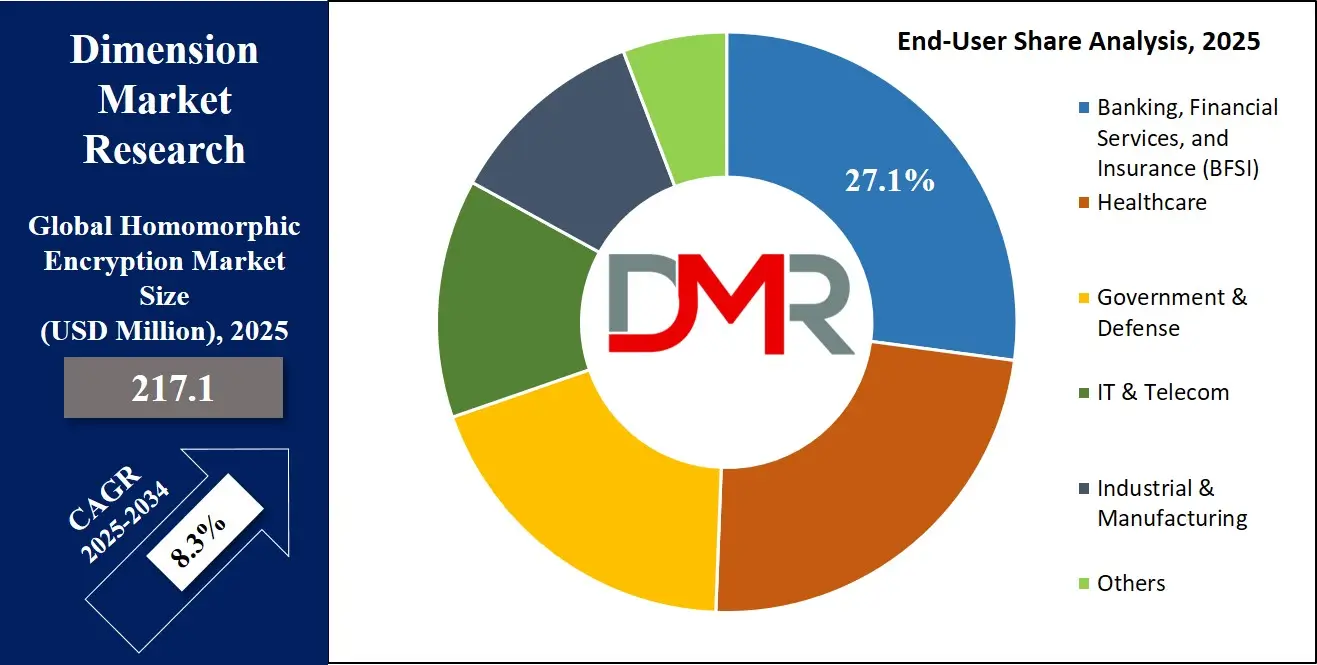
The Global Homomorphic Encryption Market Report is segmented on the basis of the following:
By Type
- Partial Homomorphic Encryption (PHE)
- Fully Homomorphic Encryption (FHE)
- Additive Homomorphic Encryption
- Multiplicative Homomorphic Encryption
By End-User
- Banking, Financial Services, and Insurance (BFSI)
- Healthcare
- Government & Defense
- IT & Telecom
- Industrial & Manufacturing
- Others
Global Homomorphic Encryption Market: Regional Analysis
Region with the Largest Revenue ShareNorth America is anticipated to lead the global homomorphic encryption market as it commands over
39.2% of the market share in 2025, due to its robust cybersecurity ecosystem, early adoption of advanced cryptographic frameworks, and heavy investments by both public and private sectors. The U.S. Department of Defense, National Security Agency (NSA), and National Institute of Standards and Technology (NIST) have prioritized the development and standardization of privacy-preserving technologies, including homomorphic encryption (HE), to secure critical national infrastructure and defense networks. Additionally, major tech giants like IBM, Microsoft, Google, and Amazon Web Services are actively investing in and offering homomorphic encryption capabilities within their cloud platforms, accelerating enterprise-level deployment.
Financial institutions in the U.S. and Canada are early adopters of HE for risk modeling, secure analytics, and anti-fraud systems. The presence of top-tier universities and research institutions fosters continuous innovation in cryptographic algorithms. North America’s strict regulatory landscape, including HIPAA, CCPA, and financial sector compliance requirements, fuels the need for secure data-in-use technologies like HE. Furthermore, the region’s high adoption rate of AI, big data, and cloud computing creates ideal conditions for HE integration. All these factors collectively contribute to North America's dominant share in the homomorphic encryption market.
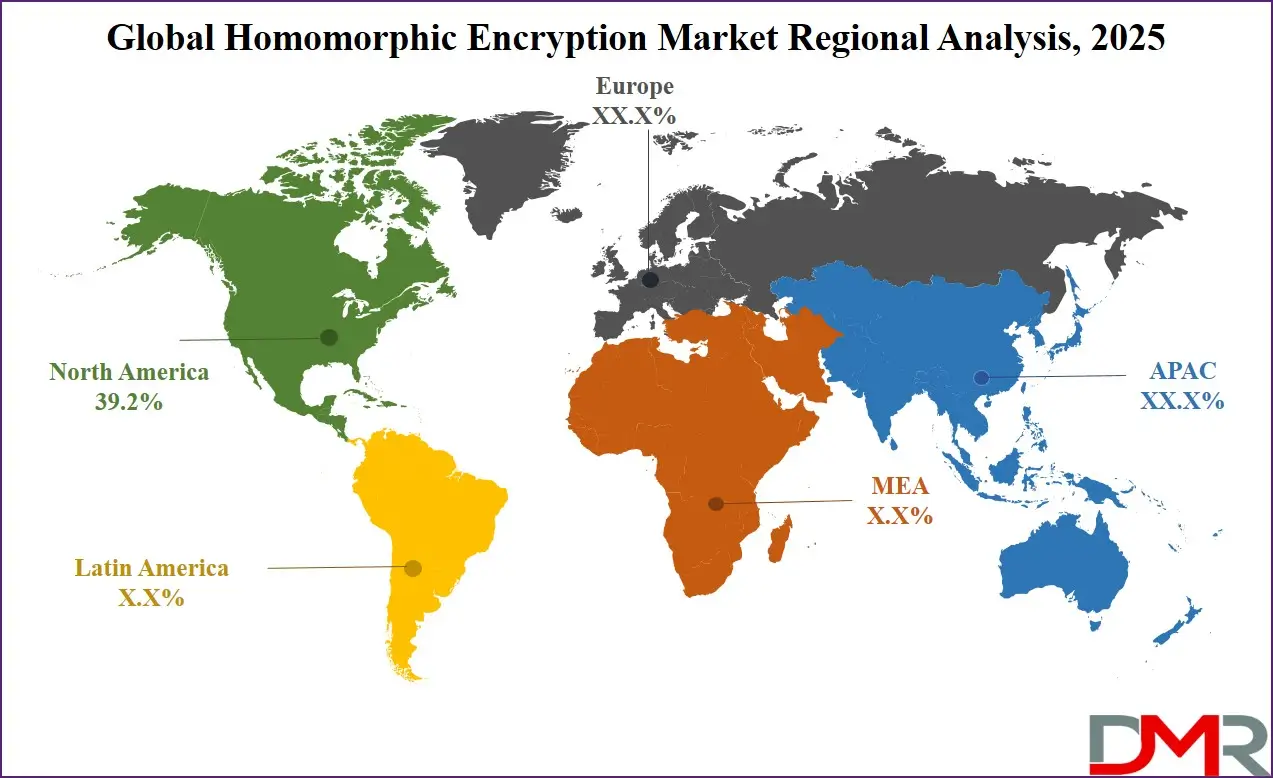
Region with the Highest CAGR
Asia-Pacific is expected to register the highest CAGR in the global homomorphic encryption market due to rising digital transformation, expanding fintech ecosystems, and evolving data protection regulations. Countries such as China, Japan, India, and South Korea are experiencing exponential growth in cloud services, AI adoption, and digital payment platforms, all of which demand secure and privacy-compliant data processing solutions. This region has witnessed a spike in data breaches and cyberattacks, pushing governments and enterprises to invest in next-generation encryption methods.
Japan’s Ministry of Internal Affairs and Communications (MIC) and India’s Ministry of Electronics and IT (MeitY) are actively promoting indigenous encryption frameworks and data protection reforms, encouraging the adoption of privacy-enhancing technologies like HE. Moreover, the Asia-Pacific region is witnessing a surge in research and pilot deployments across healthcare, telecom, and financial sectors, supported by rising public-private partnerships. As HE becomes more computationally efficient, its adoption across cost-sensitive emerging markets in Asia-Pacific is expected to surge rapidly, making it the fastest-growing regional market in the next decade.
By Region
North America
Europe
- Germany
- The U.K.
- France
- Italy
- Russia
- Spain
- Benelux
- Nordic
- Rest of Europe
Asia-Pacific
- China
- Japan
- South Korea
- India
- ANZ
- ASEAN
- Rest of Asia-Pacific
Latin America
- Brazil
- Mexico
- Argentina
- Colombia
- Rest of Latin America
Middle East & Africa
- Saudi Arabia
- UAE
- South Africa
- Israel
- Egypt
- Rest of MEA
Global Homomorphic Encryption Market: Competitive Landscape
The global homomorphic encryption market is highly dynamic, driven by a mix of established tech leaders, specialized encryption firms, and academic consortia. Key players such as Microsoft Corporation, IBM Corporation, and Google LLC lead in HE innovation, contributing to open-source libraries like Microsoft SEAL and integrating HE into their cloud-based platforms to offer privacy-preserving AI and analytics solutions.
IBM has made notable strides in enabling fully homomorphic encryption (FHE) on enterprise-grade systems, showcasing advancements in performance optimization.
Specialized players such as Duality Technologies, Inpher, and Zama are developing tailored HE tools for sectors like finance, healthcare, and data science. These companies focus on improving computational efficiency, offering software development kits (SDKs), and creating APIs for seamless HE integration. Additionally, organizations like HomomorphicEncryption.org and the PALISADE Project are pivotal in creating interoperability standards and promoting ecosystem collaboration.
Academic partnerships with institutions like MIT, Stanford, and INRIA further enhance algorithm development and security assurance. Strategic collaborations, such as Inpher’s alliance with Intel for secure AI computation, and funding rounds raised by startups across the U.S. and Europe indicate growing commercial interest. The competitive landscape is marked by rapid innovation, open-source growth, and expanding pilot deployments in regulated industries.
Some of the prominent players in the Global Homomorphic Encryption Market are:
- Microsoft Corporation
- IBM Corporation
- Google LLC
- Intel Corporation
- Thales Group
- Duality Technologies
- Zama
- Enveil
- Inpher, Inc.
- Cosmian
- ShieldIO
- CryptoExperts
- Huawei Technologies Co., Ltd.
- Apple Inc.
- Samsung SDS
- Bitfury Group
- SAP SE
- HPE (Hewlett-Packard Enterprise)
- Accenture
- Alibaba Group
- Other Key Players
Recent Developments in the Global Homomorphic Encryption Market
- March 2025 , FHE.org 2025 Conference: The 4th Annual FHE.org Conference on Fully Homomorphic Encryption was held in Sofia, Bulgaria. It featured expert presentations, poster sessions, and keynotes exploring advanced FHE research and applications.
- February 2025, NUMFOCUS Project Summit – OpenFHE Presentation: Dr. Ahmad Al Badawi presented on OpenFHE at the NumFOCUS Project Summit hosted at Microsoft's New England Research & Development Center. He discussed democratizing access to homomorphic encryption technology.
- November 2024 IPCCC 2024 – HEJet Framework Presentation: At the IEEE IPCCC 2024 in Florida, researchers presented HEJet, a framework enabling efficient machine learning inference using homomorphic encryption.
- October 2024 WAHC 2024 Workshop: The 12th Workshop on Encrypted Computing & Applied Homomorphic Cryptography (WAHC) and the 7th Standards Meeting of HomomorphicEncryption.org were hosted in Salt Lake City, USA.
- September 2024 NIST Workshop on Privacy-Enhancing Cryptography: NIST organized a 3-day workshop on privacy-preserving cryptographic protocols, with sessions specifically addressing FHE performance, applications, and security recommendations.
- August 2024 enCRYPTON Summer School: Held at Sabanci University in Istanbul, this event offered in-depth tutorials and lectures on the practical applications of homomorphic encryption and related privacy-enhancing technologies.
- July 2024 Zama at EthCC 2024: Zama participated in the Ethereum Community Conference (EthCC), where it promoted the integration of FHE into blockchain technologies and community-focused outreach via the CoFHE Shop.
- May 2024 Zama and Galactica Collaboration: Galactica.com partnered with Zama to embed FHE into its decentralized identity platform, enhancing privacy and persistent authentication in Web3 applications.
- March 2024 FHE.org 2024 Conference: The 3rd annual FHE.org Conference was held in Toronto, Canada, bringing together cryptography researchers and software developers to discuss the current state of FHE deployment.
- FSE 2024: The 30th edition of the Fast Software Encryption Conference took place in Leuven, Belgium, covering symmetric encryption and cryptographic primitives, including sessions on HE.
- January 2024 Real World Crypto Symposium 2024: Hosted in Toronto, this event connected practitioners and researchers working on real-world cryptographic applications, including privacy-preserving techniques like homomorphic encryption.